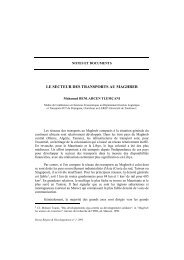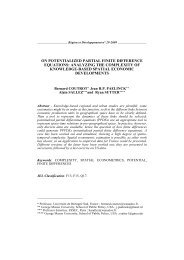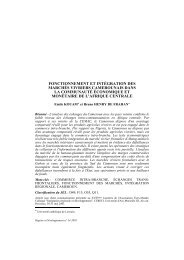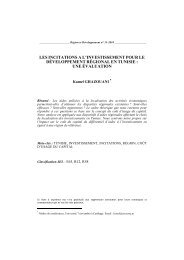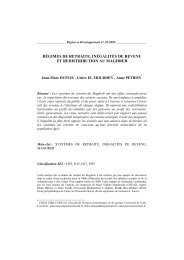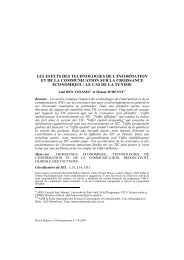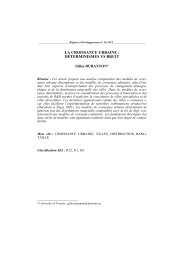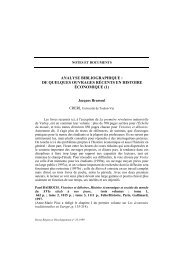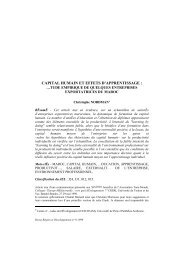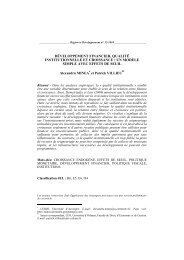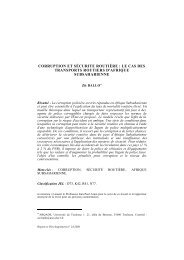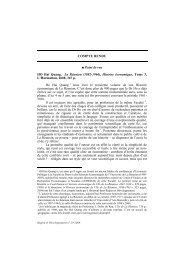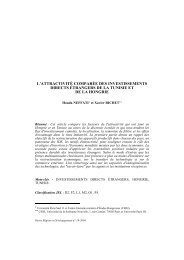space and growth: a survey of empirical evidence ... - ResearchGate
space and growth: a survey of empirical evidence ... - ResearchGate
space and growth: a survey of empirical evidence ... - ResearchGate
You also want an ePaper? Increase the reach of your titles
YUMPU automatically turns print PDFs into web optimized ePapers that Google loves.
28 Maria Abreu, Henri L.F. de Groot <strong>and</strong> Raymond J.G.M. Floraxinterpretation <strong>of</strong> the coefficients. We also mention some common misconceptionsthat are prevalent in the literature, <strong>and</strong> suggest areas where improvementscan be made.3.1. Operationalisation3.1.1. Lattice <strong>and</strong> geostatistical approachesThere are two alternative approaches for spatial statistical analysis. Thelattice or spatial process approach assumes that the unit <strong>of</strong> analysis is a discreteentity or object. Objects are linked by a spatial pattern, expressed in terms <strong>of</strong> aspatial weights matrix. Inference is based on "exp<strong>and</strong>ing domain" asymptotics,which is, adding more <strong>and</strong> more objects to the sample. Prediction is byextrapolation, that is, for a different set <strong>of</strong> spatial units, or for another timeperiod (Anselin, 2002). The variance-covariance matrix is indirectly determinedby the model <strong>and</strong> by the exogenous spatial weights matrix (discussed in the nextsection). The spatial error <strong>and</strong> spatial lag models are examples <strong>of</strong> the spatialprocess approach, as are most <strong>of</strong> the models used in the spatial econometricsliterature within economics. The reason is that most economic models are basedon discrete objects: individuals, firms, sectors, countries. A problem with thisapproach is that it is difficult to deal with missing observations, since everyobject in the model must be connected to every other via the spatial weightsmatrix.In contrast, the geostatistical or direct representation approach takes as theunit <strong>of</strong> analysis data points on a continuous field or surface. Examples <strong>of</strong> a fieldin this sense are l<strong>and</strong> prices, or average yearly rainfall. Geostatistical models donot use spatial weights matrices to summarize the spatial relationship. Thevariance-covariance matrix must be modeled directly, typically as a function <strong>of</strong>the distance between observations. There is no equivalent <strong>of</strong> the spatial lagmodel with this approach; geostatistical models apply only to the error term. Oneadvantage <strong>of</strong> this method is that it allows "interpolation", i.e. making predictionsfor missing values (known as kriging).Some studies have used the average value <strong>of</strong> proximate observations as anexplanatory variable, with the degree <strong>of</strong> proximity modeled as a distance decayfunction (e.g., Keller, 2002). The resulting model is non-linear, but can beestimated if the data is available as a panel, or at the sectoral level7.7 It should be noted that <strong>growth</strong> studies that include a physical distance function on the right-h<strong>and</strong>side<strong>of</strong> the regression are not generally considered to be examples <strong>of</strong> the geostatistical approachunless they also model the spatial autocorrelation in the error term directly by making the variancecovariancematrix a function <strong>of</strong> distance.




